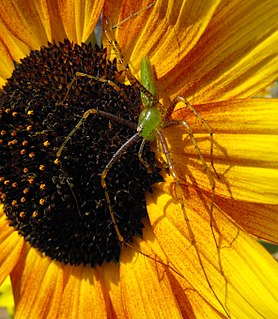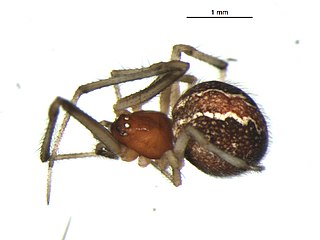
The Pholcidae are a family of araneomorph spiders. The family contains over 1,800 pholcids, including those commonly known as cellar spider, daddy long-legs spider, granddaddy long-legs spider, carpenter spider, daddy long-legger, vibrating spider, gyrating spider, long daddy, and skull spider. The family, first described by Carl Ludwig Koch in 1850, is divided into 94 genera.

The Sri Lanka spurfowl is a member of the pheasant family which is endemic to the dense rainforests of Sri Lanka. In Sri Lanka, this bird is known as haban kukula - හබන් කුකුලා in Sinhala.

Corinnidae is a family of araneomorph spiders, sometimes called corinnid sac spiders. The family, like other "clubionoid" families, has a confusing taxonomic history. Once it was a part of the large catch-all taxon Clubionidae, now very much smaller. The original members of the family are apparently similar only in that they have eight eyes arranged in two rows, conical anterior spinnerets that touch and are generally wandering predators that build silken retreats, or sacs, usually on plant terminals, between leaves, under bark or under rocks.

Nepenthes bicalcarata, also known as the fanged pitcher-plant, is a tropical pitcher plant endemic to northwestern Borneo, Indonesia. It is a myrmecophyte noted for its mutualistic association with a species of ant, Camponotus schmitzi. As an ant-fed plant it lacks many of the features that characterise the carnivorous syndrome in Nepenthes, including viscoelastic and highly acidic pitcher fluid, the waxy zone of the pitcher interior, and possibly even functional digestive enzymes.

Colobopsis schmitzi, synonym Camponotus schmitzi, is a species of ant native to Borneo, which is commonly known as the diving ant, swimming ant or pitcher-plant ant, due to their habit of diving into the digestive fluids of their plant host Nepenthes bicalcarata. They are endemic to the island of Borneo.
Genysa is a genus of East African armored trapdoor spiders that was first described by Eugène Louis Simon in 1889. As of May 2019 it contains only three species, all found in Madagascar: G. bicalcarata, G. decorsei, and G. decorsei.
Sipalolasma is a genus of brushed trapdoor spiders first described by Eugène Simon in 1892. It is restricted to South Asia and parts of Africa.
Septentrinna is a genus of corinnid sac spiders first described by A. B. Bonaldo in 2000.
Minosia is a genus of ground spiders that was first described by R. de Dalmas in 1921.
Enoplognatha marmorata, the marbled cobweb spider, is a species of cobweb spider in the family Theridiidae. It is found in North America.

Habronattus signatus is a species of jumping spider in the family Salticidae. It is found in the United States and Mexico.
Rhomphaea fictilium is a species of cobweb spider in the family Theridiidae. It is found in a range from Canada to Argentina.

Dolomedes vittatus is a species of nursery web spider in the family Pisauridae. It is found in the United States.

Peucetia longipalpis is a species of lynx spider in the family Oxyopidae. It is found in a range from the United States to Venezuela.It was first described by Frederick Octavius Picard-Cambridge in the year 1902.
Clubiona riparia, the riparian sac spider, is a species of sac spider in the family Clubionidae. It is found in Russia, Mongolia, China, Japan, and North America.

Theridion differens is a species of cobweb spider in the family Theridiidae. It is found in the United States and Canada.
Socalchemmis idyllwild is a species of false wolf spiders & wandering spiders in the family Zoropsidae. It is found in the United States.
Porrhomma convexum is a species of sheetweb spider in the family Linyphiidae. It is found in Canada, Europe, Caucasus, and Russia (European).
Crustulina altera is a species of cobweb spider in the family Theridiidae. It is found in the United States.

Habronattus texanus is a species of jumping spider in the family Salticidae. It is found in the United States and Mexico.











